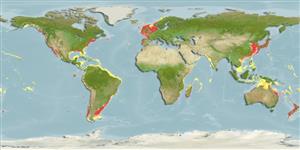Demospongiae |
Clionaida |
Clionaidae
Environment: milieu / climate zone / depth range / distribution range
Ecology
Sessile; depth range 0 - 120 m (Ref. 865). Temperate
Worldwide.
Length at first maturity / Size / Weight / Age
Maturity: Lm ? range ? - ? cm Max length : 30.0 cm WD male/unsexed; (Ref. 865)
Expose portion appears as yellow papillae; the rest of the body buried in substrate, i.e., individual cells secret material that fragments small pieces of the sponges into the substrate (Ref. 865). Bores into abalone, oyster and barnacle shells (Ref. 865).
Life cycle and mating behavior
Maturity | Reproduction | Spawning | Eggs | Fecundity | Larvae
Members of the class Demospongiae are hermaphroditic. Life cycle: The zygote develops into parenchymella larva (free-swimming) before settling down on a substrate where it grows into a young sponge.
Harms, J. 1993. (Ref. 2711)
IUCN Red List Status (Ref. 130435)
CITES status (Ref. 108899)
Not Evaluated
Not Evaluated
Threat to humans
Human uses
| FishSource |
Tools
More information
Age/Size
Growth
Length-weight
Length-length
Morphology
Larvae
Abundance
Internet sources
Estimates based on models
Preferred temperature
(Ref.
115969): 8.1 - 15.7, mean 10.7 (based on 920 cells).
Price category
Unknown.
